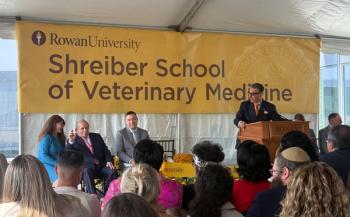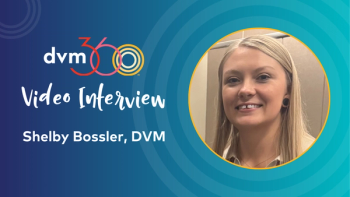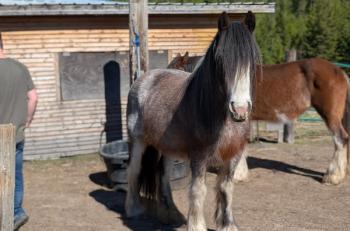
Equine ocular examination: Review of normal anatomy, diagnostics, procedures, differentials, drugs that aid in diagnostic examination and therapeutics (Proceedings)
The equine ocular exam is a routine ophthalmic exam with special consideration given to the size, temperament and use of the animal being examined.
Ocular examination
The equine ocular exam is a routine ophthalmic exam with special consideration given to the size, temperament and use of the animal being examined.
Prior to the ocular exam, general observations should include the appearance and condition of the horse and its ability to maneuver on both a flat and uneven surface. A careful history should be elicited from the owner and general observations recorded.
The order of the ocular exam always starts on the outside and moves inward in a routine and consistent fashion to avoid missing any shuttle lesions.
Start with the head and periocular tissues, and work your way to the retina. When viewing the horse head-on, note symmetry of the eyes, with particular interest on the position of the eyelids and eyelashes. Closer inspection of the periocular tissue will include the condition and amount of the orbital fat with their effect on the position of the globe. The eyelids are noted to include the lid margins for any evidence of prior lacerations. The conjunctival surfaces of the eyelid, third eyelid and are evaluated for hyperemia and chemosis. The nasolacrimal puncta are observed, both at the dorsonasal and ventronasal lid margins and at the nares.
The cornea and bulbar conjunctiva are evaluated next. The cornea should be evaluated for clarity, coloration and any breaks or changes in the surfaces. This requires bright focal illumination and is preferably performed in a dark stall with 2-4x magnification; the biomicroscope is the best instrument for this purpose. The conjunctiva should be noted for coloration or lack of coloration, especially at the lateral limbus.
Next, proceed to examination of the anterior chamber, to include the iris and the aqueous. The aqueous fluid should be clear with an absence of flare or cells. The iris surface is inspected for normal architecture, including any changes in coloration and size and appearance of the granula iridica. Atrophy of the granula iridica may indicate prior inflammation, and any cystic formation should be noted.
The lens is best examined through a dilated pupil in a dark stall. Short-acting mydriatic agent (tropicamide) will act for three to four hours, and the horse should not be ridden during this period of time. Warning: atropine, although useful for therapeutic purpose in dilating the pupil, may last upto three to four weeks and should only be used as a therapeutic agent.
The lens is evaluated for clarity and any adhesions of the iris to the lens capsule, or pigment migration on the surface of the lens capsule.
Intraocular pressures can be evaluated by using one of the newer tonometry systems. The rebound and applanation tonometers have both been used. Schiotz tonometry is impractical.
The posterior segment, including the vitreous and fundus, is examined next and requires either a direct ophthalmoscope or indirect ophthalmoscopy system. There are a number of techniques for performing indirect ophthalmoscopy, and these will be discussed. The vitreous will be evaluated for any infiltrates, floaters and liquefaction. A cloudy, liquefied vitreous is not uncommon in older horses and especially those that have prior episodes of uveitis. Evaluation of the fundus should be systematic. We recommend starting at the optic nerve and then evaluating each quadrant in a systematic fashion. The optic nerve is typically faint salmon-colored and has anywhere from 40-60 small arterioles and venules that emanate a short distance around the optic disc, and the disc always lies in the nontapetal fundus. The tapetal fundus typically has a very granular appearance, and end-on vessels, called "stars of Winslow," are often seen and are normal. A wide variety of normal colorations are noted in the tapetal fundus, and these are often related to coat color.
The neuro-ophthalmic examination should include eyelid reflexes, menace response and positional changes of the globe with movement of the head. Consensual pupillary reflexes should be evaluated by one examiner shining a bright light in one eye and looking for the associated response in the other.
Diagnostic techniques for the horse
Biomicroscopy can be simulated by using a slit-beam, which is available on many direct ophthalmoscope heads, and with loop magnification. The slit-beam is pointed at the eye at a slight angle to the area of magnification. This is best performed in a dark stall, and it helps to highlight changes in the cornea, both in coloration and thickness and surface continuity, along with flare and cells in the anterior chamber, and it gives a much better appreciation for iridal structures. The direct ophthalmoscope should be set at zero, depending on the examiner's correction, and the reflex viewed from one to two feet away as the examiner slowly moves towards the eye, through the dilated pupil to the optic nerve, and systematic exam proceeds from there. The direct ophthalmoscope generates approximately a 7-8x magnification of the posterior segment and is best for evaluation of changes in the optic disc and peripapillary area. Indirect ophthalmoscopy gives a more panoramic view and is performed with a 1420 diopter lens with focal illumination. The Finnoff transilluminator can be used as a direct source of focal illumination. More elaborate systems of head-mounted units are available from a number of suppliers. The image size achieved is approximately 0.8, which means there is actually a reduction in size of the structures. The technique of indirect ophthalmoscopy involves achieving a fundic reflex and superimposing the lens approximately 5 cm in front of the patient's eye; this permits a panoramic view of the fundus. The image is reversed and inverted. Once lesions have been located by indirect ophthalmoscopy, it is nice to follow up with direct ophthalmoscopy for a more highly magnified exam.
The order of other diagnostic techniques should follow in the order of collection of culture and sensitivity specimen, and then followed by cytology and dye staining. Tonometry can be performed, depending on the unit, at any stage following collection of culture and sensitivity specimen.
Culture and sensitivity
Culture and sensitivity specimen are best obtained by premoistening the swab to enhance the recovery of organisms. Results should be sent to a diagnostic laboratory, and requests for antibiotic sensitivity selection should be based on medications that are appropriate and available for use in the eye.
Cytology
Cytological specimen can be collected by a variety of methods, but the best in use employ micro cytology brushes, which are specifically designed to collect exfoliative cytology. Once specimen has been obtained, three to four microscopic slides are prepared. Initial evaluation includes the Wright-Giemsa types of stains. This initial evaluation will permit definition of the type of cell infiltrate and the presence or absence of bacteria and fungal elements. Other slides should be saved for special staining, including Gram stain and fungal stains.
Ophthalmic diagnostic stains
A number of ophthalmic stains are available to further elucidate the state of health of the cornea and conjunctiva. These include the fluorescein dye stains, which are hydrophilic and are repelled by healthy corneal epithelium. Stain retention indicates a break in the epithelium. The underlying stroma is hydrophobic and absorbs the stain. Deep ulcers that extend to Descemet's membrane do not retain stain. Another stain that is useful in equine medicine is Rose Bengal stain. Rose Bengal is a vital stain and is retained by nonvitalized epithelial cells. It has been helpful in demonstrating early fungal infections. The order of stains is typically fluorescein dye followed by Rose Bengal. Instillation of the stain can be directly from strips impregnated with dyes, or dyes can be suspended in solution and then spritzed into the eye with a tuberculin syringe using the hub, with the needle removed from the end of the syringe.
Tonometry
Modern tonometry applies two techniques; one of flattening the cornea, referred to as applanation tonometry, and another technique of bouncing a tiny probe off of the surface of the eye, which is referred to as rebound tonometry. Both are fairly accurate in estimating intraocular pressures. Glaucoma may be more prevalent in equine medicine, originally unrecognized because of the infrequent use of tonometry.
Nerve blocks
Nerve blocks aid in the examination of a horse, once the general examination has been completed and neuro-ophthalmic observations have been recorded. Nerve blocks involve either blocking the motor nerve (branch of seven), which can be performed over the zygomatic arch area, and this technique will be reviewed during the presentation. Sensory nerve blocks can be made at four points surrounding the eye, and we will review the locations of these blocks.
Treatment methods
Various topical preparations can be applied to the eye, and these include solutions, suspensions and ointments. Subconjunctival injections and subpalpebral lavage systems also aid in treating the fractious patient. Antibiotics commonly used in the horse include chloramphenicol, aminoglycosides and a variety of fluoroquinolones. Antifungal agents include miconazole, itraconazole and voriconazole.
Cycloplegic agents are helpful in controlling pain of uveitis and prevention of adhesions. Atropine is the most common one used. Care should be used in prescribing atropine because of the increased risk of colic. Anesthetic agents used for blocks include lidocaine and bupivacaine, while proparacaine and tetracaine are used for a topical anesthetic.
Anticollagenase agents help in the reduction of keratomalacia that is common with aggressive corneal ulcers. Products used include potassium EDTA, serum and acetylcysteine. Oral doxycycline may be helpful too.
Newsletter
From exam room tips to practice management insights, get trusted veterinary news delivered straight to your inbox—subscribe to dvm360.






